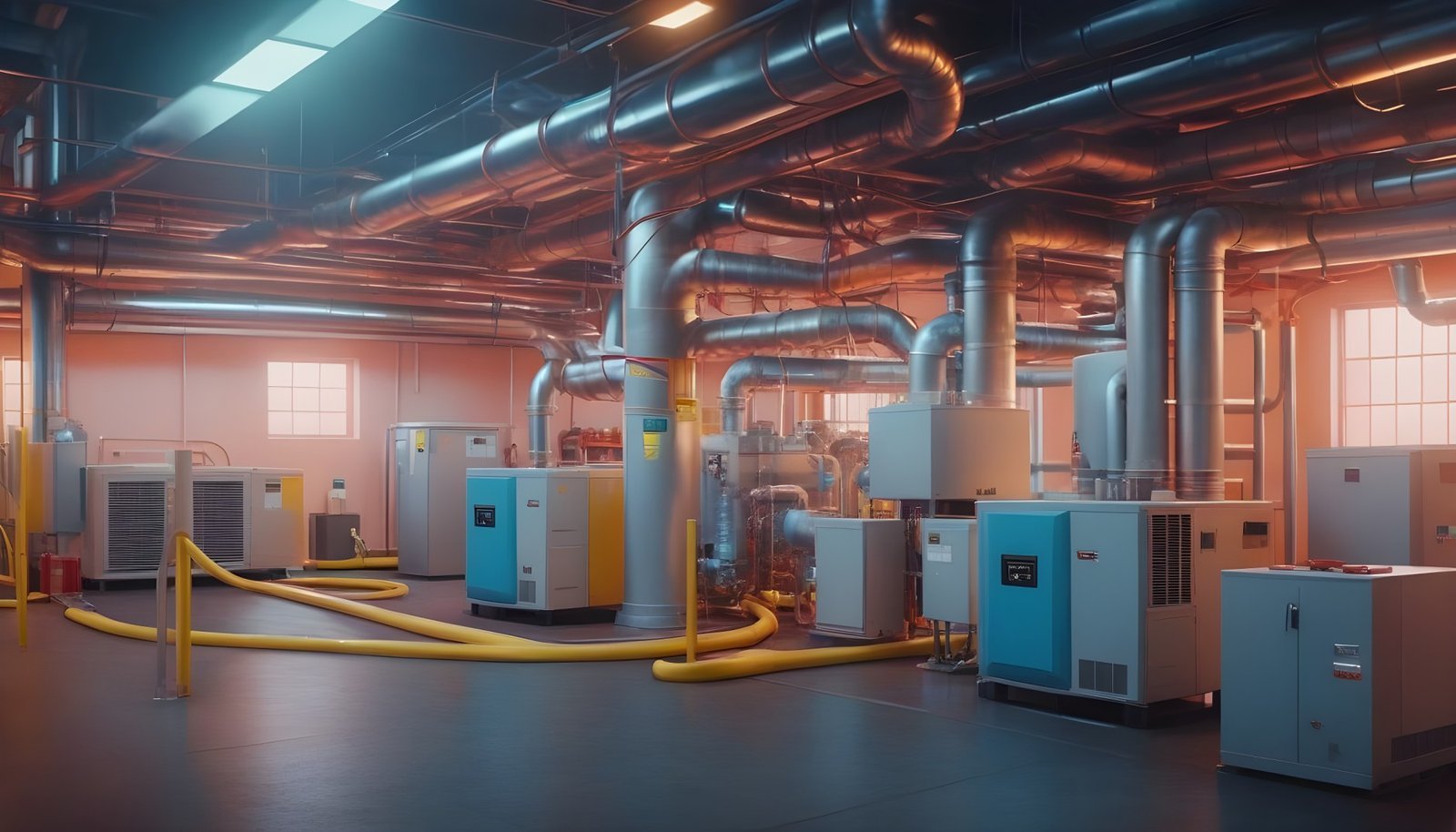The HVAC industry, a cornerstone of maintaining comfortable indoor environments, has witnessed unprecedented growth in tandem with technological advancements. As the demand for skilled HVAC professionals continues to soar, the importance of obtaining proper certification has become paramount for individuals aiming to carve a niche in this dynamic field. This article aims to provide a comprehensive exploration of HVAC certification, placing a particular emphasis on the significance of EPA 608 certification. Moreover, it will delve into the intricate process of securing lucrative job opportunities post the attainment of this pivotal milestone.
Unraveling the Essence of HVAC Certification
HVAC certification stands as a formal acknowledgment, a tangible testament to an individual’s adeptness in the intricate realms of installing, maintaining, and repairing heating, ventilation, and air conditioning systems. It serves as a hallmark of a technician’s knowledge and skills, instilling confidence in both employers and clients regarding their competence in navigating the complexities of HVAC equipment.
The EPA 608 Certification: A Beacon of Excellence
Among the myriad certifications available in the HVAC industry, the EPA Section 608 certification shines brightly as a beacon of excellence. This certification, mandated by the United States Environmental Protection Agency (EPA), stands as a legal prerequisite for anyone involved in the handling of refrigerants. The EPA 608 certification is intricately categorized into four types, with Type II emerging as particularly relevant and indispensable for HVAC technicians seeking to advance their careers.
HVAC Certification EPA 608 and its Types
The EPA Section 608 certification, designed to meticulously regulate the usage of refrigerants, manifests itself in four distinct types, each catering to specific aspects of the HVAC landscape.
1. Type I: Small Appliances Mastery
This certification focuses on the nuances of handling small appliances containing five pounds of refrigerant or less. Technicians equipped with Type I certification demonstrate proficiency in addressing the unique challenges posed by compact HVAC systems.
2. Type II: Tackling High-Pressure Appliances
Delving into the intricacies of high-pressure appliances, Type II certification is a prerequisite for those dealing with residential air conditioners and heat pumps. This certification equips technicians with the expertise to navigate the complexities of advanced HVAC systems.
3. Type III: Mastery of Low-Pressure Appliances
Addressing the subtleties of low-pressure appliances, Type III certification is imperative for technicians working on chillers. This certification ensures that professionals are well-versed in the specific challenges posed by low-pressure HVAC systems.
4. Universal Certification: Comprehensive Proficiency
Universally encompassing Types I, II, and III, the Universal Certification is a comprehensive acknowledgment. It is indispensable for technicians who handle a diverse array of HVAC systems, showcasing versatility and proficiency across the spectrum.
The Importance of EPA 608 Certification
EPA 608 certification is not just a legal requirement; it is a mark of professionalism and responsibility in the HVAC industry. It demonstrates a technician’s commitment to environmental protection and adherence to regulations governing the use of refrigerants. Employers actively seek certified technicians to ensure that their HVAC systems are serviced and maintained by individuals who prioritize safety and environmental sustainability.
The Journey from HVAC Training to Industry Mastery
Embarking on a fulfilling career in the HVAC industry is an exciting endeavor that begins with a crucial foundation—comprehensive training. This phase of the journey involves immersing oneself in HVAC training programs offered by trade schools and vocational institutions. These specialized courses not only cover the fundamental principles of HVAC systems but also delve into the intricacies of refrigeration and the safe handling of refrigerants. Aspiring technicians undergo a transformative learning experience, setting the stage for a successful and rewarding career in the HVAC field.
HVAC Training: Crafting Competent Professionals
The cornerstone of any successful HVAC career is a robust training program. HVAC training goes beyond theoretical knowledge, providing hands-on experience that is essential for mastering the complexities of heating, ventilation, and air conditioning systems. These programs are designed to equip students with the practical skills and technical expertise required to excel in the field.
- Fundamental Principles: HVAC training programs commence with an in-depth exploration of the fundamental principles that govern heating, ventilation, and air conditioning systems. Students gain a solid understanding of thermodynamics, fluid mechanics, and heat transfer—the building blocks of HVAC engineering.
- Refrigeration Mastery: As refrigeration is a core component of HVAC systems, training programs dedicate significant attention to this aspect. Students learn about the various types of refrigerants, their properties, and the intricacies of refrigeration cycles.
- Safe Handling of Refrigerants: An essential aspect of HVAC training involves educating students on the safe and responsible handling of refrigerants. This knowledge is not only crucial for the EPA 608 certification exam but also for ensuring the well-being of technicians and the environment.
Trade Schools: Nurturing Talent for the HVAC Industry
Trade schools play a pivotal role in shaping the next generation of HVAC professionals. These institutions provide a focused and streamlined approach to education, preparing students for the practical challenges they will encounter in the field. The curriculum is crafted to align with industry standards and demands, ensuring that graduates are well-prepared for the rigors of HVAC work.
Trade School Advantages:
- Specialized Curriculum: Trade schools offer specialized HVAC courses that go beyond generic education. Students delve into the specifics of HVAC technology, troubleshooting techniques, and system optimization.
- Hands-On Experience: Unlike traditional academic settings, trade schools prioritize hands-on experience. This approach allows students to apply theoretical knowledge in real-world scenarios, fostering a deeper understanding of HVAC systems.
- Preparation for EPA 608 Certification: Recognizing the significance of EPA 608 certification in the HVAC industry, trade schools incorporate preparatory modules into their curriculum. This proactive approach ensures that graduates are well-positioned to successfully navigate the certification process.
Entry-Level Proficiency: A Key Outcome
Upon completion of HVAC training at trade schools, graduates emerge not only with a comprehensive understanding of HVAC systems but also with a level of proficiency that qualifies them for entry-level positions. This marks the transition from theoretical learning to practical application, as newly minted HVAC professionals embark on their career journeys armed with knowledge, skills, and the coveted EPA 608 certification.
The Crucial Role of Entry-Level Positions
Entry-level positions serve as the proving ground for newly certified HVAC technicians. These roles provide invaluable opportunities to apply theoretical knowledge in real-world settings, honing skills and gaining practical insights into the day-to-day challenges faced by HVAC professionals. Whether working on residential air conditioners, heat pumps, or other HVAC systems, entry-level technicians contribute to the overall functionality and efficiency of these systems.
Entry-Level Responsibilities:
- System Installation: Entry-level technicians often assist in the installation of HVAC systems, learning the nuances of the process under the guidance of experienced professionals.
- Routine Maintenance: Performing routine maintenance tasks is a common responsibility for entry-level technicians. This includes tasks such as cleaning filters, inspecting components, and ensuring optimal system performance.
- Troubleshooting: Entry-level professionals participate in troubleshooting exercises, identifying and addressing common issues that arise in HVAC systems. This hands-on experience is invaluable for developing problem-solving skills.
Navigating the Certification Landscape: Preparing for EPA 608
While HVAC training at trade schools provides a solid foundation, the journey is not complete without obtaining the necessary certifications. The EPA 608 certification, in particular, holds paramount importance in the HVAC industry. As technicians transition from entry-level positions to more advanced roles, having EPA 608 certification becomes a hallmark of professionalism and compliance with environmental regulations.
EPA 608 Certification Preparation:
- Integration into Curriculum: Trade schools seamlessly integrate EPA 608 certification preparation into their curriculum. This includes focused study sessions, practice exams, and guidance on the regulatory aspects of handling refrigerants.
- Understanding Regulatory Compliance: Technicians are educated on the legal and environmental implications of working with refrigerants. This knowledge not only prepares them for the certification exam but also instills a sense of responsibility regarding environmental stewardship.
- Practical Application: Theoretical knowledge is complemented by practical application, allowing technicians to demonstrate their understanding of EPA regulations in simulated scenarios. This approach ensures that technicians are well-prepared to apply their knowledge in real-world situations.
Empowered Graduates: Ready for the HVAC Industry
Armed with comprehensive HVAC training, trade school education, and the EPA 608 certification, graduates emerge as empowered professionals ready to make a significant impact in the HVAC industry. Their journey from the classroom to entry-level positions and certification attainment positions them as skilled technicians, poised for success in a rapidly evolving field.
The Significance of Specialty Certifications and NATE Certification in HVAC Excellence
In the dynamic landscape of the HVAC industry, achieving the fundamental EPA 608 certification is merely the first step on the path to becoming a distinguished HVAC technician. Recognizing the need for continuous growth and specialization, technicians often pursue additional certifications to enhance their marketability and showcase expertise in specific areas. This article sheds light on the importance of specialty certifications, with a spotlight on the North American Technician Excellence (NATE) certification, and emphasizes the pivotal role of gaining hands-on work experience in shaping a well-rounded HVAC professional.
Unlocking Opportunities: Specialty Certifications
While EPA 608 certification is a prerequisite for working with refrigerants, savvy HVAC technicians understand the value of distinguishing themselves further through specialty certifications. These certifications allow technicians to showcase their expertise in specific aspects of HVAC systems, offering a deeper level of understanding and proficiency. One such noteworthy certification is the North American Technician Excellence (NATE) certification.
NATE Certification: A Mark of Distinction
NATE certification stands as a pinnacle of achievement in the HVAC industry. Widely recognized and respected, NATE certification validates a technician’s mastery in key HVAC areas, including installation, service, and system optimization. Technicians who attain NATE certification demonstrate a commitment to excellence and a comprehensive understanding of the intricacies involved in various facets of HVAC operations.
Specializing with NATE Certification
The NATE certification encompasses various specialized areas within the HVAC realm, allowing technicians to tailor their expertise to specific niches. The certification is available in multiple disciplines, including:
- Installation: NATE-certified technicians specializing in installation possess advanced skills in setting up HVAC systems, ensuring optimal performance, and adhering to industry best practices.
- Service: Technicians with a NATE certification in service excel in diagnosing and repairing HVAC systems. Their expertise extends to troubleshooting issues and implementing effective solutions, minimizing downtime for clients.
- System Optimization: NATE-certified technicians specializing in system optimization focus on enhancing the overall efficiency and performance of HVAC systems. This includes fine-tuning components, optimizing energy usage, and ensuring systems operate at peak levels.
The Impact of Specialty Certifications on Marketability
Obtaining specialty certifications, including NATE certification, significantly enhances a technician’s marketability in the competitive HVAC job market. Employers actively seek technicians with demonstrated expertise, and specialty certifications provide tangible evidence of a technician’s commitment to continuous learning and professional development.
Marketability Benefits:
- Expanded Skill Set: Specialty certifications showcase an expanded skill set, allowing technicians to take on diverse HVAC challenges with confidence.
- Industry Recognition: Employers recognize and value specialty certifications, viewing them as a testament to a technician’s commitment to excellence and industry standards.
- Client Confidence: Specialty-certified technicians inspire confidence in clients, assuring them of a technician’s ability to address specific HVAC needs with precision and proficiency.
Gaining a Competitive Edge: Work Experience in HVAC
In conjunction with certifications, practical experience plays a pivotal role in shaping a well-rounded HVAC professional. Employers often prioritize candidates with hands-on knowledge gained through apprenticeships, internships, or entry-level positions. Working under the guidance of seasoned professionals not only hones technical skills but also provides invaluable insights into real-world challenges and solutions.
Hands-On Learning: The Crucial Role of Work Experience
- Apprenticeships: Engaging in apprenticeships provides aspiring HVAC technicians with the opportunity to work alongside seasoned professionals. This hands-on experience allows them to observe and actively participate in real-world HVAC scenarios, accelerating their learning curve.
- Internships: Internships offer a structured environment for gaining practical experience. Interns contribute to projects, apply theoretical knowledge, and gain exposure to the day-to-day operations of HVAC systems.
- Entry-Level Positions: Starting in entry-level positions allows technicians to apply their foundational knowledge in real-world settings. They become adept at system installations, routine maintenance, and troubleshooting, gradually building expertise that goes beyond the classroom.
The Symbiosis of Certification and Experience
The synergy of specialty certifications and hands-on work experience creates a formidable combination, positioning HVAC technicians as sought-after professionals in the industry. Certified HVAC technicians with practical experience bring a unique blend of theoretical knowledge and applied skills, ensuring they are well-equipped to handle the complexities of modern HVAC systems.
Navigating the HVAC Job Market: From EPA 608 Certification to Career Triumph
Armed with the EPA 608 certification and relevant training, the journey towards a successful HVAC career takes a significant stride with the creation of a compelling resume. Crafting a standout document is more than just listing qualifications; it’s about showcasing achievements and certifications that make a candidate stand out in a competitive job market. Certified technicians must emphasize their HVAC license, proficiency in handling air conditioners, and any additional certifications such as NATE to grab the attention of potential employers.
Job Search Strategies: Navigating the Digital Realm
Effective job searching in the modern era involves a strategic approach to utilizing various channels and platforms. Online job boards, company websites, and industry-specific platforms serve as excellent resources for discovering HVAC job opportunities. However, the journey doesn’t stop there. Networking within the industry, attending trade events, and becoming a part of professional organizations can open doors to potential employers. This multi-faceted strategy ensures that aspiring HVAC professionals cast a wide net, increasing the likelihood of finding the perfect job match.
Acing the Interview: Beyond Technical Prowess
Securing a job interview marks a significant milestone, and preparation is the linchpin to success. Beyond technical knowledge, candidates must be ready to discuss problem-solving skills and experiences that exemplify their ability to handle HVAC systems effectively. Familiarity with industry trends, and emerging technologies, and a commitment to ongoing professional development can set candidates apart during the interview process. The interview is not just an assessment of technical prowess but a chance to showcase a holistic understanding of HVAC systems, emphasizing the importance of air quality and the overall impact of the HVAC professional’s role.
Elevating Your HVAC Career with ATS-Optimized Resume Services
Crafting a standout resume is essential in securing a fulfilling HVAC career, and leveraging the right tools can make all the difference. Aspiring technicians equipped with EPA 608 certification, HVAC licenses, and additional certifications such as NATE should consider optimizing their resumes for Applicant Tracking Systems (ATS). These systems, widely used by employers to manage and filter resumes, require a strategic approach to ensure that your qualifications don’t get overlooked. Our services specialize in ATS resume and CV optimization, tailoring your document to meet the specific criteria these systems prioritize. By partnering with us, you enhance your chances of standing out in the competitive HVAC job market, allowing your comprehensive skill set and certifications to shine through seamlessly. Take the next step in your HVAC career journey by ensuring your resume reflects not only your expertise but also aligns perfectly with the expectations of modern hiring processes. Check our Services!
Conclusion: Paving the Way for HVAC Certification Excellence
In conclusion, the journey from EPA 608 certification to a rewarding career in the HVAC industry is multifaceted. Understanding the nuances of EPA 608 certifications, pursuing comprehensive HVAC training, gaining hands-on experience, and strategically approaching job applications are critical components. As the HVAC industry continues to evolve, staying updated on advancements, obtaining additional certifications such as NATE, and prioritizing environmental responsibility contribute to long-term success.
The guidelines outlined in this article serve as a roadmap for aspiring HVAC technicians, providing confidence in navigating the certification landscape. By adhering to these principles, individuals can position themselves as sought-after professionals in the dynamic realm of heating, ventilation, and air conditioning. The commitment to continuous learning, combined with a strategic approach to job searching and a focus on holistic HVAC expertise, sets the stage for a rewarding and fulfilling career in an industry that plays a pivotal role in ensuring comfort and efficiency in indoor environments.








0 Comments